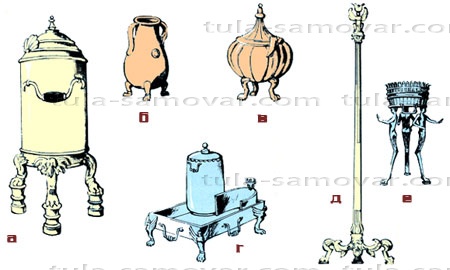Antique Samovars

The roots of the history of the samovar go far deeper than one might imagine. The simplest constructions, similar to modern samovars, are not only mentioned in written sources, but are also known from archeology data in the era of the highly developed civilization of Ancient Rome. To denote such devices, the ancient Romans even had a special term - "autepsa." Electric samovars to the Romans, for obvious reasons, were not known - they used heat devices for heating water.
These devices were a large vessel, in the middle of which there was a hole, and through this hole in one of the two internal tanks laid hot charcoal, pre-burned from firewood in the hearth furnace. The water tank was located at the top of the device and was separated from the coal tank by the inner iron plate of the vessel. Autepsa did not have a tap - water was poured into it and was taken from it with the help of a scoop. Due to the absence of the cover above the water tank and the uncovered hole for laying the coal below the water tank, this device had a low efficiency, giving away a significant part of the heat from the combustion of coal into the environment.
A more advanced model of the ancient Roman device for heating water with its layout resembled a modern samova. A compartment for hot coal was in the center, and a compartment for water - around it. In this model, there was a side opening for steam removal, and often a lower grate serving to remove ash and air access to the coal, which made the combustion process more intense and, accordingly, effective in terms of heat release. Autopsa was not self-sufficient devices, but was used as an addition to the home and in a complex with it (coal was taken from the hearth).
An interesting fact is that in the cold season the autopsy was used to heat water, and in the hot season, on the contrary, to cool it. For this purpose, ice from the home ice reserve, which was in rich houses, was put in a coal tank. But what kind of drinks did the Romans drink in a warm and chilled form? The answer is rather unexpected, since it is a question of the same drink - wine, diluted with water. Contrary to popular belief, the Romans diluted the wine with water not in order to less get drunk. Imperfect technology of wine production at that time led to the fact that the wine was too thick for use in undiluted water.
